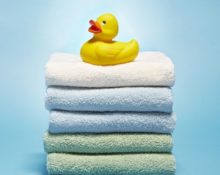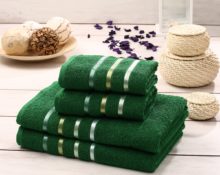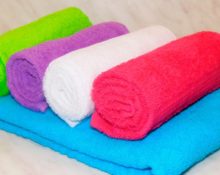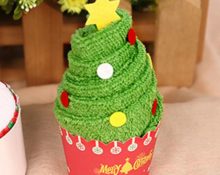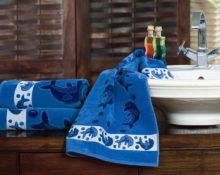For any person, a towel is an indispensable household item. Terry cloth is most often used as a bath towel or towel for the face and hands. Choosing a good towel that will serve you for a long time is not the easiest task. How to do this - read on.
Criteria for choosing a terry towel
In order for the product to last at least 2-3 years and not become rough after several washes, you need to pay attention to several important points before purchasing. Why spend money on something that you won't use or will wear out very quickly?
What size do you need?
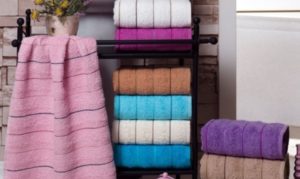 First decide for what purpose do you want to buy a new towel?. Based on this, the size of the product is determined. Typically the following types and sizes are distinguished:
First decide for what purpose do you want to buy a new towel?. Based on this, the size of the product is determined. Typically the following types and sizes are distinguished:
- for hands - 30×50 or 50×70 cm;
- for the face, legs or as a small towel for the body - sizes from 50x80 to 50x100 cm;
- bath towel − 100×150 or 80×160 cm.
Of course, other sizes may be available for sale.
Important! Stores often sell sets of several towels of different sizes. This is very convenient, because, firstly, all the textiles in your bathroom will match in style, and secondly, it is very functional and saves time when purchasing.
We evaluate the quality of the fabric
When purchasing textiles in a store, we can only evaluate external qualities. Always pay attention to the following points:
 integrity of the material. On a quality product, all terry loops should be approximately the same length. There should be no loose or protruding threads;
integrity of the material. On a quality product, all terry loops should be approximately the same length. There should be no loose or protruding threads;- uniformity of coloring, dye fastness;
- edge processing: please note on the quality of hems and seams: the threads should not come out of it; if the edge is edged, then evaluate whether it is well sewn to the main material (the frequency of stitches should be quite high - about 25 for every 10 cm of fabric).
Pile parameters
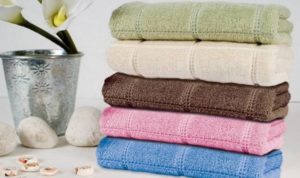 The length of the lint loops is an important component of a quality item. The optimal length of the pile is about 5 mm. Shorter bristles (less than 3mm) will not provide sufficient absorption. The towel will get wet very quickly and will be unpleasant to use. The pile that is too long (about 1 cm) looks very beautiful when purchased, but after the first wash in the machine the product loses its appearance. The loops may catch and unravel and become stiffer and untidy.
The length of the lint loops is an important component of a quality item. The optimal length of the pile is about 5 mm. Shorter bristles (less than 3mm) will not provide sufficient absorption. The towel will get wet very quickly and will be unpleasant to use. The pile that is too long (about 1 cm) looks very beautiful when purchased, but after the first wash in the machine the product loses its appearance. The loops may catch and unravel and become stiffer and untidy.
It depends on the length of the pile and on the material in general. product rigidity. Short pile is always stiffer than long pile. Please note that very often textiles that are soft to the touch contain synthetic materials, many of which do not absorb moisture well.
Textile density
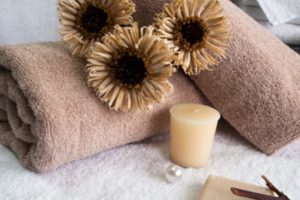 This criterion is very important, because the service life of the product directly depends on it. However, it is quite difficult to evaluate it in a store, since this can only be done by eye. The fact is that density is measured in g/m². This means that you need to weigh the towel when purchasing, which is quite problematic. There is usually no information about density on the label.
This criterion is very important, because the service life of the product directly depends on it. However, it is quite difficult to evaluate it in a store, since this can only be done by eye. The fact is that density is measured in g/m². This means that you need to weigh the towel when purchasing, which is quite problematic. There is usually no information about density on the label.
The density of a good towel should be at least 450-500 g/m². There is a high probability that an item with a density of less than 300 g/m² will not last you even a year.
Absorbent properties
High quality terry fabric should absorb water well. This property depends on the composition of the material, as well as on the type of thread from which it is made. Has the best absorbent properties natural fabric, especially cotton. Pay attention to the label: It is believed that the best cotton towels are made in factories in Pakistan, Uzbekistan, Turkey and Egypt.
As for the threads from which terry fabric is made, they come in three types:
- double - made of two twisted threads;
- combed;
- twisted (one tightly twisted thread).
Give preference to a towel made of combed terry fabric. This will ensure maximum water absorption.
How to navigate the compositions?
The best terry towel should consist of natural fiber. Most often they are made from:
- cotton - a product made from cotton terry is incredibly soft and delicate, perfectly absorbs moisture;
- linen - such textiles will last a long time because they are quite wear-resistant;
- bamboo - in addition to the above properties, a bamboo product has antibacterial properties.
Important! On the label of home textiles you can see a designation that, at first glance, indicates an absolutely natural composition.It might look like this: "100% cotton (P)". In fact, the composition contains artificial fiber polyester, which, although its properties resemble cotton, is not identical to it.


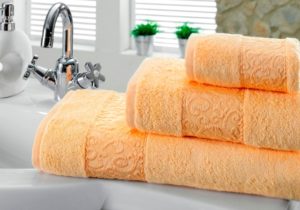
 0
0
